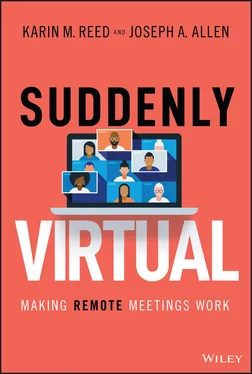The Video Portal: A Window into Our Coworkers' Homes
One of the more intriguing aspects of video meetings for suddenly remote teams was the opportunity to see our coworkers in a whole new light due to our ability to see them in a whole new environment. Admit it. You spent way too much time obsessing over someone's cool kitchen or what appeared to be a world‐class collection of bobbleheads lined up on a bookshelf in the background.
At the workplace, we tend to define our teammates mainly by their roles in the organization, and we view them through that prism. After all, our interactions with them are mainly professional, with perhaps a handful of relationships that go below the surface.
That curated veneer was stripped away to some degree by the video portal created by the reliance upon virtual communication. Not only did it afford the opportunity to check out everyone's space outside of the office, but it also allowed us to see our coworkers as whole people rather than just their roles. Who knew that Brenda has a green thumb with a penchant for orchids or that Chris collects beer cans from all over the world and displays them in alphabetical order on built‐in shelves crafted for that purpose?
We also met their children, their pets, their significant others, and their roommates in a way that felt simultaneously refreshing and invasive. What made it okay was the fact that everyone was in the same situation. One of the early suggestions to newly remote workers was to give context to your work‐from‐home space – let everyone know the unique challenges you face to create understanding. Knowing what each person was dealing with in this new virtual environment led to less eye‐rolling and more empathy. If someone suddenly muted their audio during a video meeting, perhaps it was because their elderly dog who refused to sit more than two feet from his master started to snore at a decibel that was untenable. Technical challenges might be attributed to bandwidth creaking under the weight of two adults simultaneously conducting virtual meetings, while their two little ones tried to navigate online school.
Psychological science backs the interesting benefits and occasional drawbacks of this new level of familiarity. The research is pretty clear that familiarity with others breeds liking, empathy, compassion, attraction, but also occasional contempt (e.g. a Red Sox fan disheartened to realize his coworker is a diehard Yankees fan) (Curtis, Rhoades, and Waguespack Jr 2012; Zagefka, Noor, and Brown 2013; Rindfleisch and Inman 1998). In one study, researchers found that knowledge of disaster areas increased willingness to donate, suggesting that familiarity bred compassion behavior. While the adage states that to know a person, one must walk a mile in their shoes, perhaps getting a glimpse of their book collection will suffice in helping us understand them a bit more.
In so many ways, we were all in this together, and the impacts on relationships with our coworkers are still being evaluated and analyzed today.
The Value of Video for External Meetings
Perhaps no team within an organization was more deeply affected by the stay‐at‐home dictates than the sales force. While some companies were exclusively selling virtually, most were not, and that pivot for some organizations felt akin to turning a giant cruise ship. It can be done but not without a lot of effort and forethought. Sales folks, by their very nature, crave face‐to‐face interaction. Without being able to begin a sales call with a handshake, what was the best alternative?
Since the pandemic began, almost 90% of business‐to‐business (B2B) sales have moved to a remote model, whether that be videoconferencing or phone. Certain sectors – technology, media, and telecom especially – are leading the way, but according to McKinsey, “Sales leaders are already moving quickly to navigate the crisis, with the best ones focusing on how to make targeted changes that help their businesses weather the storm and start preparing for the recovery” (Gavin et al. 2020).
While digital sales channels (think mobile apps, social media channels, and online communities) are gaining in importance, the person‐to‐person experience is still one of the cornerstones of sales strategy. COVID‐19 forced sales leaders to determine what that would look like in the new normal. For many organizations, person‐to‐person became video‐image‐to‐video‐image, and they were pleasantly surprised by the results and the impact on the bottom line. According to Gong, the #1 remote sales platform, prior to the pandemic, 41% more deals were won when the webcam was on during virtual sales calls, which is unsurprising, considering what a video‐enabled meeting offers. Video humanizes the message, allows you to deeply connect and build and foster relationships – all powerful tools in any sales strategy (Orlob 2019).
While some organizations are just dipping their toes into using video on sales calls, other companies are going beyond real‐time videoconferencing and embracing asynchronous video for email outreach. Platforms like BombBomb and Vidyard allow sales professionals to create personalized videos to send out to prospects. With shifts in how humans consume information, betting on video to cut through the noise seems like a pretty safe bet. Research by Wyzowl, a video marketing firm, shows that 66% of consumers prefer watching a video to reading about a product (Santora 2020). Video in an email is surely a differentiator from the typical text‐only (PDF attached) version, and it delivers a message in a way that most people prefer.
The exploration of new ways of selling came at a critical time for many businesses. For example, in the pharmaceutical and biotechnology industries, product launches planned for years needed to be mapped out using virtual strategies never imagined prior to the pandemic. Savvy sales leaders recognized that their sales forces needed to be equally as competent and confident on camera as they were in person because their go‐to market strategy might be completely virtual, totally in‐person, or a combination of the two.
Those who try to wait it out for a return to “normalcy” do so at their own peril. According to McKinsey, “B2B sales operations going forward will look fundamentally different from what they were before the pandemic.” With video as a core component of the sales process, best‐in‐class organizations are moving to create best‐in‐class virtual communicators and investing in the technology and training to stand out (Gavin et al. 2020).
By June 2020, videoconferencing had been fully embraced and entrenched in corporate America. According to a survey conducted by Demand Metric in the spring of that year, 95% of respondents reported using video meetings regularly for work, with 87% of them saying they use it more than ever before. However, the accelerated adoption due to work from home, travel restrictions, and social distancing has not been without some speedbumps (Metric 2020).
A full 94% of those who were engaging in virtual video meetings encountered barriers in using the tools effectively. The top three were video quality issues, video call fatigue, and technical issues (with keeping people's attention a close fourth). Furthermore, even if they manage to overcome the barriers, very few people have been trained on how to optimize those meetings. As it turns out, following meeting science and video communication best practices can go a long way in making virtual meetings work. We will look at both in Section 2(The Meeting Scientist Perspective) and Section 3(The On‐Camera Coach Perspective).
Читать дальше












